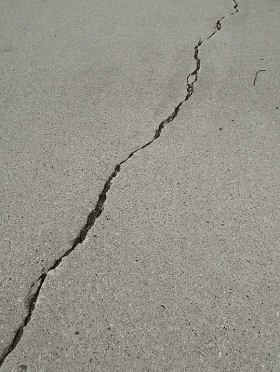- Rapid Water Evaporation from the Concrete Surface: Moisture is a leading cause of concrete floors cracking and breaking. Our moisture mitigation products are the best way to prevent further cracking on your floors.
- Poorly-Compacted Soil Underneath the Concrete: Soil beneath concrete floors can shift or move over time, causing the concrete to crack. Water pooling underground can also raise or lower the land beneath the content and affect the concrete’s stability.
- Concrete Shrinkage During Drying: Wide temperature fluctuations and weather patterns can influence how the cement dries and lead to cracking.
- Corrosion of Steel Bars Underneath Concrete: Oxidation of the steel bars used to reinforce the concrete can cause cracks to form.
- Consistently Exceeding the Concrete's Load Capacity: Prolonged pressure from heavy vehicles like semi-trucks can lead to cracks in concrete surfaces if the weight exceeds the concrete’s load limit.
To prevent premature cracking in your concrete flooring, consider using Bone Dry's sealers and moisture mitigation products, designed to protect your floors and extend their lifespan.
Get Concrete Sealers from Bone Dry
How Do You Prevent Concrete Cracking?
The best way to prevent cracks is to take every possible precaution during the pouring process. When pouring concrete, consider:
- Structural Design: Contraction, expansion and isolation joints need to be constructed at reasonable intervals beneath reinforced concrete. Proper width and spacing are essential for making concrete flooring as strong as possible.
- Mixing Materials: Cement mixtures are strongest when not contaminated with foreign materials like clay or dirt. A larger amount of aggregate in the cement plays a crucial role in crack prevention, and a smaller amount of water in the concrete mixture can help reduce shrinkage.
- Placement: A properly compacted subgrade (the ground beneath where the cement is being poured) is important for preventing cracks from occurring in concrete. A careful inspection of the subgrade is essential for preventing crack formation.
- Finishing and Curing: Curing cement as quickly as possible helps make it stronger and reduces the risk of cracking. Using a dehumidifier can encourage the concrete to dry faster by reducing the dew point of the air surrounding the cement.
Bone Dry Products can help prevent cracking
Bone Dry concrete moisture mitigation products are water-based, penetrating sealers that produce a waterproof barrier deep within your concrete floor, preventing cracking and breaking within the cement. Unlike epoxies and other sealants, Bone Dry sealers are more versatile and up to four times more affordable, making them an easy-to-apply and cost-effective solution.
Use Bone Dry’s professional moisture mitigation products including our Original sealer, Etch-A-Crete and EM Coating to help prevent cracking and create a long-lasting barrier against moisture, one of the leading causes of concrete cracking and deterioration.
The moisture mitigation products we offer for your next project include:
- Penetrating Sealers: Deep sealing action to stop moisture from surfacing –
- Concrete Preparation Products: Etch hard-troweled concrete and seal porous cement based structures –
- Surface Coatings: Semi-gloss and waterproof surface sealers –







